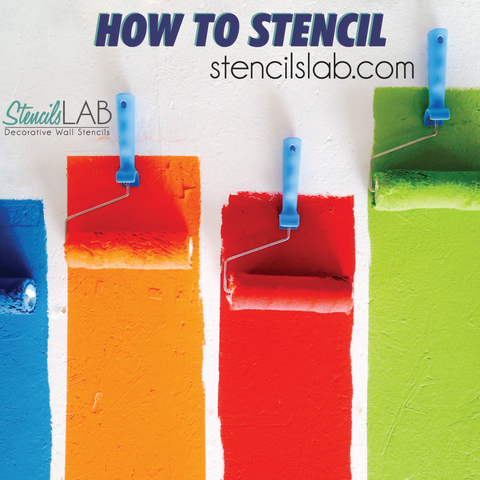How to Stencil.

Before beginning any stenciling project, it is essential that your surface is prepared correctly. It is best to stencil surfaces that are as smooth as possible. If the surface is not smooth, the stencil will not produce clean, crisp designs. *(If working with wood, the best way to smooth a surface is with fine sandpaper).
If the background of your project needs a base coat, pick your background color and paint with a foam brush. *Foam brushes cover a lot of areas quickly and smoothly. They are also washable so that you can use them over and over.
Pour a small amount of paint on a plate or palette, about the size of a quarter. Dip just the tip of your brush or sponge into the paint. If using a brush, with a circular/swirling motion, remove excess paint on a different paper plate or paper towel until the brush is "dry." Too much paint on the brush causes blotchy designs. If using a sponge, start dabbing and 'pushing/working' the paint into the sponge until the sponge feels almost 'dry'/moist (NOT WET!) *Remember - stenciling is a "dry" brush technique. The most common mistake is overloading your brush. It is far better to stencil a few layers gradually, instead of one thick paint application. If paint begins to 'bleed' behind your stencil or if your designs do not have crisp, defined edges, YOU ARE USING TOO MUCH PAINT.
Once the brush is load, test (practice) on an area of your paper plate to test the imprint. The brush/sponge is properly loaded when there is a uniform (almost powdery) looking imprint on the plate. There should be nothing wet or sloppy.
Once brush/sponge is loaded… You are ready to stencil! There are different ways to stencil. The most common is either the 'stippling' or 'swirling' technique. Stippling is straight up and down motion. Swirling is in a circular motion. Here is what I recommend:
LARGER AREAS - I like to use sponges. With a sponge, you can cover a larger area MUCH faster and will have a smooth (non-stippling) finish. It covers fast and evenly distributes the paint... then the second layer with the swirling technique (to give it a sharp/crisp edge)
SMALL/DETAILED AREAS - I like to use the swirling technique. The reason this is the best technique for a tiny detailed area is when you're swirling it gets those tiny edges and corners that are hard to distribute evenly when just stippling or sponging. Swirling is the BEST choice for detailed or sharp areas. *Important: …when using this technique, your brush needs to be very 'Dry/Damp' …if it's too wet, it will look sloppy and leak. Be patient, and even if it takes a few coats, it will look just beautiful and crisp in the end! J
When finished stenciling, carefully peel off the stencil.
How to flatten a curled stencil:
Since our larger stencils have to be rolled/shipped in a box- sometimes when they are shipped during a hot season (summer) or to a warmer area, they may have a slight ‘curl’ to them. There are a few things you can do to flatten your stencil. You can lay your stencil under some books or even under an area rug (leave it overnight). If there a just a small area/letter curled, you try gently curling it in the opposite direction with your fingers. OR…. lay your stencil flat on the table and put paper on top (tissue paper, newspaper, etc), then roll it in the opposite direction of the curl, then place it back in the box (or tube, etc) and blow a hairdryer into it for a minute or two, then quickly take it out of the box and lay it flat under books for 1-2 hours. ….*If you are trying to flatten your stencil after you have painted it multiple times, make sure to clean all the paint off your stencil… multiple layers of paint collected on a stencil (especially in delicate/ thin areas) can cause a warped/curl look. See tips on cleaning.

